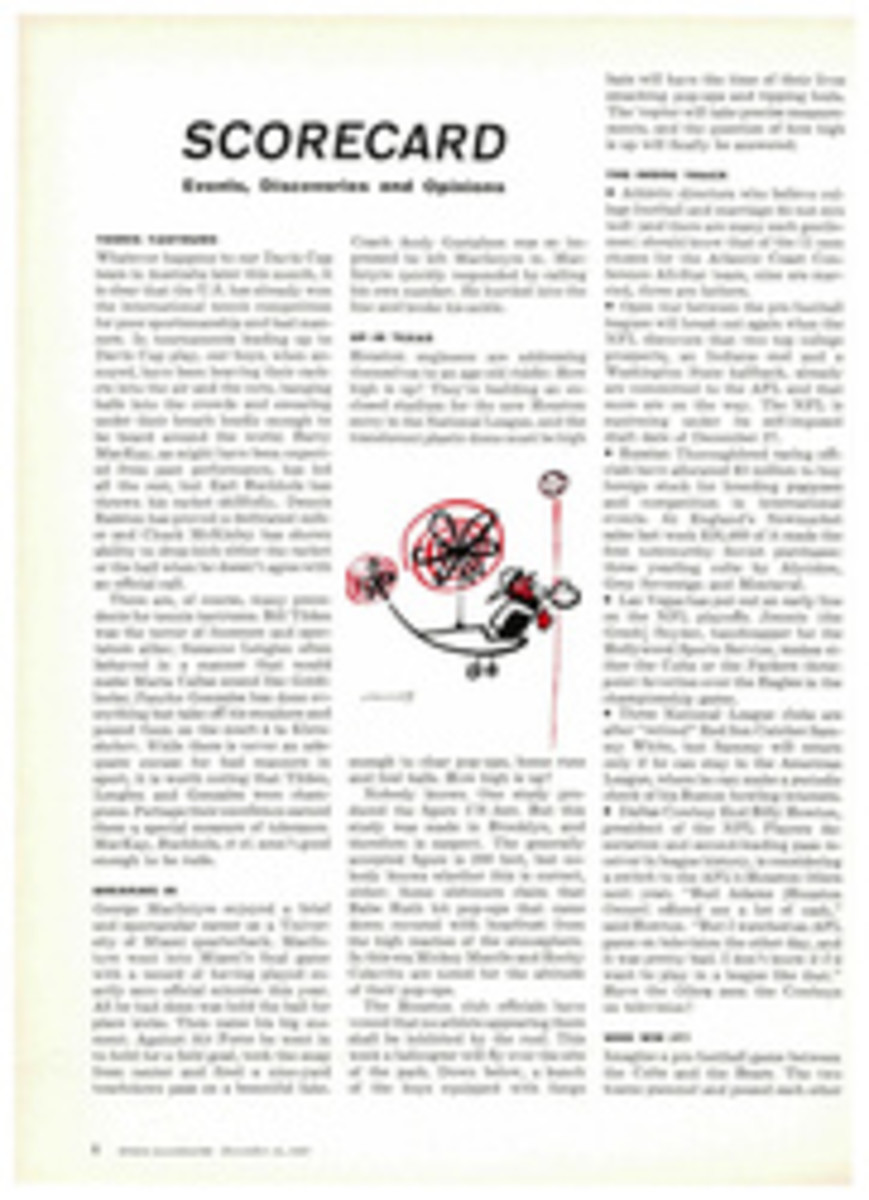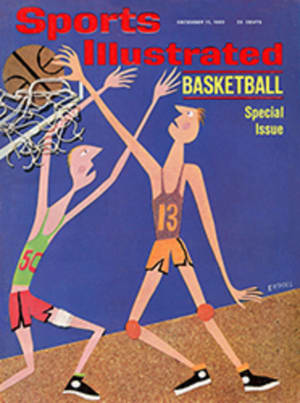
PUT AWAY THE FLOWERS!
When the bell rang ending the 15th and last round of his fight last Saturday night with Middleweight Champion Gene Fullmer, Ray Robinson tottered happily into the arms of his handlers and an admirer jumped up onto the ring apron shouting, "Put away the flowers, boys! The man ain't dead yet!"
For a few breathless, exciting seconds, it seemed that the incredible had happened again, that the Lazarus of boxing was once more among the quick. It may well be, centuries from now, that the kind of people who won't believe the stories of Robin Hood, King Arthur, Paul Bunyan or even Wyatt Earp, won't believe the legend of Sugar Ray Robinson either. Yet there were 14,130 boxing fans in the Los Angeles Memorial Sports Arena to attest that not only is there really a Sugar Ray, but that he is truly one of the extraordinary human beings of our day. It was not so much that he was fighting to regain the middleweight championship for an unbelievable fifth time, and at an age (40) when most men are finding it more and more painful to play a game of catch with their sons—it was that he so very nearly won it. In fact, in the minds of the referee and all but a handful of eyewitnesses (two of them, unhappily, judges of the fight), he did win it.
The three California officials, not uncharacteristically, disagreed violently about the fight. One of them, Referee Tommy Hart, thought Robinson had won it all the way—11 to 4 was his count. A judge, Lee Grossman, presumably looking at the same ring and for the same things, thought Fullmer had an edge, and a big one, 9 to 5. The deciding judge, George Latka, thought it was closer than California's vote in the Nixon-Kennedy match. He called it even, 8-8. This made the fight a draw and Fullmer a kind of half champion.
The decision, as anticlimactic as a handshake from Marilyn Monroe, threw the crowd into shock. Even Fullmer himself stared for a full five seconds before he regained his composure; his manager, Marv Jenson, explained that Gene was surprised because he thought he had won handily. Fullmer said nothing.
For Robinson, the decision had the effect of letting the air out of his elation. Lazarus had been returned to limbo. Fullmer, retaining his title by a draw for the second time in a year, was still champion. But for Gene Fullmer—to whom retaining his title should have been all that mattered—it was further galling proof that the old champion who has been a taunt to him ever since they first met nearly four years ago still wears no man's yoke and has not yet met his master. For Ray Robinson, it was a triumph in spirit.
Like Fullmer, the gamblers were saved by the decision. They had made the champion a 9-to-5 favorite in fairly heavy action.
The fight was slow in coming to steam. Robinson, who barely made it to the finish line in his two recent gavottes with the taffy-punching Paul Pender, was pacing himself, although ever watchful for the chance to throw one perfect punch as he had when he flattened Fullmer the last time they met, in May 1957.
Except that Fullmer was more cautious and did not leave the field of battle feet first this time, the fight was a reprise of their two earlier meetings. The clumsy, artless mink farmer fought awkwardly, elbows foremost, popping left hands downward like a man driving nails with the flat of his hand. His right was restricted to a futile effort that came flailing out of a crouch and whistling behind the back of Sugar Ray's head.
Sugar Ray's art, as usual, was endless. He fought only one minute of any round but did so with such command and élan that it was enough to establish, if anyone thought it needed establishing, who was the aristocrat of this cruel ordeal and who was the lout. It was even possible to feel pity for Gene Fullmer as he came into the ring, earnest eyes peering out of a lumpy, kindly face. He was met by such a torrent of venomous boos that one might have supposed a poor-box robber had just been introduced. The sportswriters, adoring of Sugar Ray in prefight stories, had published things like "Sugar Ray sat there regally, trim, handsome, unmarked by combat. You looked at this magnificent athlete and were seized by a disquieting feeling. You envisioned him losing to a clobbering brute whose style was an affront to Sugar Ray's art."
Sugar wasn't home
Sugar Ray looked a good deal less reassuring to Champion Fullmer. It was evident that Gene had signed for the fight not only in the hope of redeeming himself for the 1957 knockout, but of avenging a series of slights by Sugar Ray in the intervening years—little things like not accepting Fullmer's phone calls when Fullmer knew perfectly well he was there, and big ones like limiting Fullmer to a meager 12½% of the gate and no TV money for their first fight.
Where Gene was quietly determined, Manager Marv Jenson was blustery and cocksure. "Robinson is nothing but an ungrateful, no-good bum," he shouted on one occasion during prefight training. "I hope Gene puts him in the hospital for six months."
In the fight, Gene appeared a good deal more concerned with keeping himself out of the hospital. He showed almost too much respect for the Robinson punch. He had heard stories that the Robinson he was meeting was a counterfeit Robinson, a shell of the man who had upended him with one punch three years before, but it was evident he didn't believe them. Not even with eight-ounce gloves, which California insists that fighters over 147 pounds use instead of the normal six-ouncers, did Fullmer feel safe. He joined the battle with a peekaboo defense that, by comparison, would have made a turtle look recklessly vulnerable. When he finally satisfied himself that Robinson was not going to take him out again with one punch, it was very nearly too late—and might have been too late in any case had it not been for the judges.
Fullmer's strategy was to let Robinson wear himself out in the early rounds and then polish him off in the finale. But the foils of Robinson were magnificent in this duel, and not even Fullmer's water buffalo charges could dent Sugar Ray's aplomb. It was hard to believe that the superbly conditioned Robinson could ever have been pressed by a clutcher like Paul Pender, but Manager George Gain-ford, as usual, had an explanation. Robinson, he said, had not trained as assiduously for Pender as he had for Fullmer. With Fullmer, he took no chances.
Robinson's strategy was simple: get himself in as good condition as possible, fight his fight and trust the memory of the knockout to psyche Fullmer out of really believing in himself. It might very well have worked. In the dressing room after the fight Fullmer, an extremely honest man, readily admitted that he might have been too cautious. "But he can knock you out if he hits you clean," Fullmer reminded his audience, one of whom then asked, "Did any of his punches hurt you?" "No," answered Fullmer, "but neither did the one he knocked me out with." The memory of waking up on the floor in May 1957, asking "Why did they stop it?" and being told, "Because the count was 11," was still with him.
Sugar Ray, as usual, had come to town with an entourage so large and colorful that the uninformed might have thought a convention was on. Ray admitted that it cost him more than his cut (estimated at $40,000 before taxes) to feed, transport and house this human menagerie. The usual secretary, manager, barber, masseur, manicurist, golf teacher, golf companion, two assistant trainers, a minister in clerical collar and a camp hostess who called him "Darling," were joined this time by a voice coach, replacing the drama coach he had on his last visit West. During training, before he would do up his hair, get his nails buffed and hold court in bed with the press standing around like hospital visitors, Sugar Ray would favor the folks with a few songs. Not the old stand-bys of Irving Berlin or Elvis Presley but arias from Simon Boccanegra, an opera from the far reaches of Verdi, so far in fact that it is almost never performed in this country—outside of Ray's fight camp.
Real art
Even in the dressing room after the deadly draw, the operatic quality remained. Solicitous handlers applied ice packs and eye drops and made loud vehement comments on the rank robbery of the decision, but Robinson seemed above it, world-weary, eyes brimming with sadness. Ray, in short, seemed too sugary. "I'm sorry I let you down," he whispered apologetically to the clustered press. Would he fight again? "I don't know if I'm interested in boxing anymore." He refused, rolling his eyes toward heaven, to criticize the decision of the judges. "Oh, no," he said reproachfully, "I couldn't do that. Please, fellows, don't ask me to do that."
But just as it seemed that Robinson was going to throw himself wholeheartedly into the role of Camille, a scene that could only take place in Hollywood suddenly put the fight in its proper aspect as a mere diversion. An Italian movie producer appeared at the dressing room door in the tow of George Gainford, and behind him slithered a pneumatic blonde in silver mink and a black-lace dress cut low enough to make any garage calendar in the country.
Sugar Ray brightened considerably. The ice bag disappeared, the eye dropper was put out of sight, and the cameras began popping. The vision inhaled deeply and blew her bangs out of her false eyelashes. Then she posed with Ray, who grinned idiotically through it all. It appeared that this was show business. Gain-ford, who speaks a kind of singsong Elizabethan English anyway, except when he is mad, announced, after some conversations in fractured French with the producer, that this was Signorina Rita Giannuzzi who was going to make a movie in Italy with Ray that would be "a drama, not about prizefighters and will have no racial questions."
They just won't believe the Sugar Ray legend a thousand years from today. Why should they?
PHOTO
MATADOR ROBINSON gets ready to match his skill against another of Fullmer's bull-like but dangerous charges.
PHOTO
GENE'S CROUCH WAS NO GREAT HELP AGAINST ROBINSON
PHOTO
SUGAR RAY DEFTLY SLIPPED THE CHAMPION'S ROUGH CHARGES
PHOTO
IN HOLLYWOOD SCENE IN DRESSING ROOM RAY POSES WITH ACTRESS RITA GIANNUZZI, HIS CO-STAR IN FORTHCOMING MOVIE
FIVE-TIME CHAMP
Sugar Ray Robinson failed last week in his effort to become middleweight champion for the sixth time, but his five successful ascents to the title are a vital part of boxing lore:
Feb. 14, 1951. Robinson knocks out Jake LaMotta to win championship.
Sept. 12, 1951. Robinson knocks out Randy Turpin to win back title.
Dec. 9, 1955. Robinson knocks out Bobo Olson to regain title second time.
May 1, 1957. Robinson knocks out Gene Fullmer to win back title again.
March 25, 1958. Robinson decisions Carmen Basilio to recapture championship for fourth time.

